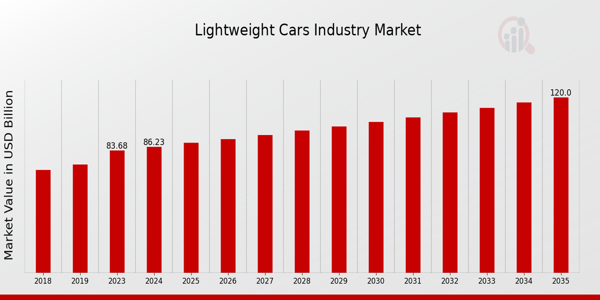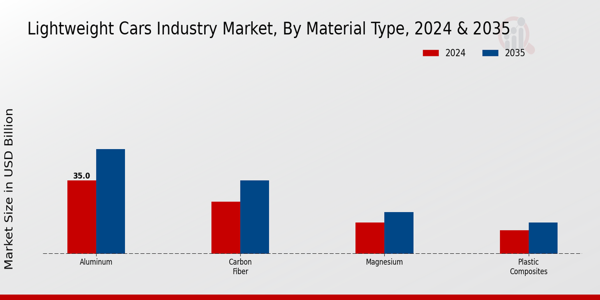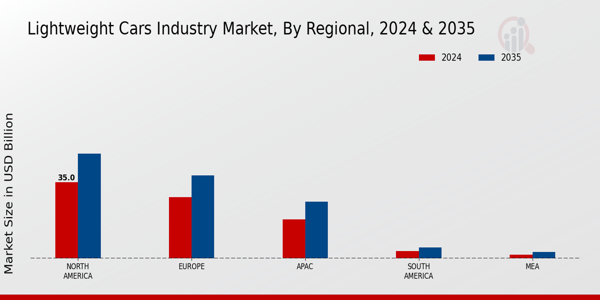Global Lightweight Cars Market Overview
As per MRFR analysis, the Lightweight Cars Market Size was estimated at 83.68 (USD Billion) in 2023. The Lightweight Cars Market is expected to grow from 86.23 (USD Billion) in 2024 to 120.0 (USD Billion) by 2035. The Lightweight Cars Market CAGR (growth rate) is expected to be around 3.05% during the forecast period (2025 - 2035).
Key Lightweight Cars Market Trends Highlighted
The increased desire for environmental sustainability and fuel efficiency is driving a substantial amount of momentum in the worldwide lightweight car market. Manufacturers are being pushed to create lighter automobiles by rising fuel prices and more stringent pollution standards. These vehicles perform better and use less energy.
Additionally, automakers can now cut vehicle weight without sacrificing durability or safety because to technological improvements in materials like aluminum and carbon fiber. This change not only improves fuel efficiency but also satisfies consumer demands for greener solutions.
As consumers grow more conscious of the effects on the environment, there are more and more opportunities in the lightweight vehicle sector.
There is a growing acceptance of electric and hybrid vehicles, which often utilize lightweight designs to maximize efficiency. Companies focusing on innovative materials and manufacturing techniques may find niche markets to explore, particularly in regions where sustainability is a priority.
Collaborations between automotive manufacturers and material scientists can also lead to breakthroughs that capture a larger share of the market. Recent trends indicate a shift towards automation and smart technology integration in lightweight vehicles.
As manufacturers work to include advanced driver-assistance systems, the demand for lightweight structures that house these technologies is rising. Moreover, the emphasis on electric vehicles is prompting the industry to invest more in lightweight designs that extend battery life and range.
The continuous shift towards sustainability and innovation shapes the direction of the lightweight cars market, highlighting the importance of agility and adaptability in responding to consumer needs and regulatory requirements.

Source: Primary Research, Secondary Research, MRFR Database and Analyst Review
Lightweight Cars Market Drivers
Increasing Fuel Efficiency Demand
The Lightweight Cars Market is experiencing a significant push due to the rising demand for fuel efficiency in vehicles. As consumers become more environmentally conscious and fuel prices continue to fluctuate, there is a growing preference for lighter cars that can offer improved mileage.
Lightweight cars typically utilize advanced materials and innovative design techniques that contribute to lower overall weight, thus enhancing fuel economy. This trend is particularly evident in urban areas where fuel constraints and economic considerations play a crucial role in purchasing decisions.
The efficient use of lightweight materials not only responds to consumer demands but also aligns with governmental regulations aimed at reducing carbon emissions. As the Lightweight Cars Market progresses, manufacturers are increasingly investing in research and development to create lighter, more efficient vehicles, reflecting a broader shift in the automotive sector towards sustainability.
Additionally, the need for compliance with stringent emissions standards being adopted across various regions is further driving the adoption of lightweight vehicles as a viable solution.
This demand for increased fuel efficiency is expected to propel market growth significantly, as both existing automotive players and new entrants strive to capitalize on this opportunity, positioning lightweight cars at the forefront of innovative automotive solutions in the coming years.
Technological Advancements in Material Science
Advancements in material science are revolutionizing the Lightweight Cars Market by introducing a variety of advanced materials that contribute to weight reduction without compromising safety or performance.
The development of materials such as aluminum, carbon fiber, and high-strength steel allows manufacturers to build lighter vehicles while enhancing structural integrity. This innovation aligns with industry trends favoring a transition towards more sustainable vehicle production processes.
As explorations into new composites and manufacturing techniques continue, the potential for creating even lighter and more efficient cars is expanding. The introduction of these advanced materials is pivotal in reshaping the automotive landscape, making it a key driver of growth in the market.
Stringent Emission Regulations
Increased governmental efforts to combat climate change have led to stricter emission regulations across various countries. The imposition of these regulations directly influences the Lightweight Cars Market, as automakers are compelled to innovate and reduce vehicle weight to meet compliance standards.
Lightweight cars are favored as they typically produce lower emissions, making them an attractive option for consumers and manufacturers alike. As these regulations become more pronounced, the automotive industry is likely to experience a significant shift towards the development and production of lighter, more eco-friendly vehicles.
Lightweight Cars Market Segment Insights
Lightweight Cars Market Material Type Insights
The Lightweight Cars Market, segmented by Material Type, showcases significant diversity and growth potential.
Within this segment, Aluminum stood out as a predominant choice, valued at 35.0 USD Billion in 2024, and it is projected to grow to 50.0 USD Billion by 2035. Aluminum's lightweight properties and cost-effectiveness contributed to its major appeal, making it an essential component in the quest for fuel efficiency and performance enhancement in automobiles.
In comparison, Carbon Fiber played a vital role as well, valued at 25.0 USD Billion in 2024 and anticipated to rise to 35.0 USD Billion by 2035. Its high strength-to-weight ratio was significant in high-performance and luxury vehicles, rendering it a compelling alternative; however, its relatively higher cost limits broader adoption in more economical car models.
Magnesium, valued at 15.0 USD Billion in 2024, was also an important player in this market, with a forecasted increase to 20.0 USD Billion by 2035. This metal gained traction due to its excellent lightweight characteristics, making it useful in components where weight reduction was critical.
Plastic Composites, valued at 11.23 USD Billion in 2024 and expected to reach 15.0 USD Billion by 2035, represent a versatile option in lightweight car manufacturing as well. These materials offered the benefit of resilience and moldability, which contributed to creative and innovative designs, appealing to manufacturers aiming for fuel efficiency while maintaining aesthetic values.
The growth drivers for the Lightweight Cars Market included stringent regulations on emissions and the growing demand for fuel-efficient vehicles, which make the materials utilized in this market increasingly significant.
Each material type presented unique challenges and opportunities, with Aluminum dominating the market currently due to its balance of affordability and lightweight attributes, while Carbon Fiber remains important for high-performance sectors despite its cost implications.
As the market evolves, continued advancements in material technology and manufacturing processes could provide opportunities for further growth and diversification within the sector, contributing to the overall Lightweight Cars Market revenue and influencing future trends in vehicle design and performance.

Source: Primary Research, Secondary Research, MRFR Database and Analyst Review
Lightweight Cars Market Vehicle Type Insights
The Lightweight Cars Market is primarily segmented by Vehicle Type, with key categories including Hatchback, Sedan, SUV, and Crossover.
The SUV category has garnered substantial interest, attributed to its versatility and ability to cater to a wide range of consumers, becoming a preferred choice among families and adventure seekers. Sedans continue to hold a notable position in the market due to their efficiency, performance, and comfort features, appealing to a diverse demographic.
Hatchbacks are recognized for their practicality and compactness, making them increasingly popular in urban settings where space is a constraint. Meanwhile, Crossovers blend characteristics of SUVs and sedans, offering consumers the benefits of both categories, thus driving their market significance.
The segmentation within the Lightweight Cars Market underscores diverse consumer preferences, highlighting important trends shaped by factors such as environmental concerns, fuel efficiency norms, and evolving lifestyle choices.
Overall, the Lightweight Cars Market statistics reveal a dynamic landscape where each vehicle type caters to distinct needs, presenting opportunities for further innovation and market expansion
Lightweight Cars Market Powertrain Type Insights
The Lightweight Cars Market has shown a notable trend towards the diversification of powertrain types. Among the various powertrain configurations, the Internal Combustion Engine continues to hold a substantial share, driven by its established infrastructure and consumer familiarity.
As environmental concerns grow, the demand for Hybrid and Electric powertrains has surged, reflecting a shift towards more sustainable transportation solutions. Electric powertrains are gaining momentum, appealing due to their efficiency and lower emissions, while the Fuel Cell segment is emerging as a promising alternative with advantages in refueling and range.
This bifurcation in the powertrain types drives innovation and offers consumers various performance and environmental benefits.
The market growth is bolstered by advancements in technology and supportive government regulations aimed at reducing carbon footprints, paving the way for further developments in these segments. As consumer preferences shift and technology evolves, the landscape of the industry is set to continue transforming.
Lightweight Cars Market Application Insights
Among these, urban transportation is a key area due to the increasing focus on sustainability and the need for efficient mobility solutions in densely populated areas.
Long-distance travel is also significant, as lightweight vehicles offer improved fuel efficiency and comfort over extended journeys. Personal use continues to dominate the market, with consumers seeking vehicles that provide a balance between performance and eco-friendliness.
Commercial use is gaining momentum, driven by fleet operators looking to reduce operational costs while enhancing their sustainability image. Together, these applications contribute to shaping the Lightweight Cars Market data and highlight key trends such as affordability, fuel efficiency, and environmental concerns, fueling continued market growth.
Lightweight Cars Market Regional Insights
The Lightweight Cars Market showed a diverse regional landscape, with North America leading the sector, valued at 35.0 USD Billion in 2024 and projected to grow to 48.0 USD Billion by 2035, reflecting its significant demand for sustainable automotive solutions.
Europe followed closely, with a market value of 28.0 USD Billion in 2024, expected to rise to 38.0 USD Billion, driven by stringent emissions regulations and a robust shift towards electric vehicles.
The Asia-Pacific region, with a valuation of 18.0 USD Billion in 2024, is anticipating an increase to 26.0 USD Billion, showcasing rising consumer preferences for lightweight vehicles amidst urbanization and environmental awareness.
In contrast, South America and the Middle East and Africa displayed smaller market sizes, with South America at 3.5 USD Billion and MEA at 1.73 USD Billion in 2024, highlighting emerging markets but lower adoption rates compared to the leaders.
The global market growth dynamics were primarily influenced by technological advancements, consumer trends toward fuel efficiency, and legislative support, creating opportunities across regions, while challenges included infrastructural limitations and varied regulatory frameworks that could impact market penetration strategies.

Source: Primary Research, Secondary Research, MRFR Database and Analyst Review
Lightweight Cars Market Key Players and Competitive Insights:
The Lightweight Cars Market has been experiencing significant competitive dynamics as manufacturers strive to innovate and differentiate themselves in response to growing consumer preferences and regulatory pressures for fuel efficiency and lower emissions.
The emphasis on sustainability and environmental consciousness has propelled manufacturers to develop lightweight vehicles that maintain performance while reducing weight. This shift not only enhances the fuel economy of cars but also positions brands favorably in a marketplace increasingly focused on sustainability.
Competitive insights reveal that companies are actively investing in advanced materials such as aluminum and carbon fiber, which help to drastically reduce the weight of vehicles without compromising safety or structural integrity.
The market is characterized by robust research and development efforts, strategic partnerships, and a keen focus on technology integration, including electric and hybrid options that benefit from lightweight designs.
Hyundai has established a significant presence in the Lightweight Cars Market by leveraging its strengths in design innovation and technological advancement. The brand has effectively utilized its expertise in materials science to produce lightweight vehicles that feature advanced safety systems and enhanced fuel efficiency.
Hyundai’s commitment to sustainability is evident in its strategic initiatives that prioritize eco-friendly production processes and the incorporation of alternative powertrains, making its lightweight cars appealing to a broad consumer audience.
Another strength is Hyundai’s robust global supply chain, which allows for efficient production and distribution, ensuring that new lightweight models can rapidly reach markets worldwide.
The company’s investment in research and development, particularly in the area of lightweight materials and electric vehicle technology, fortifies its competitive edge, enabling Hyundai to maintain a leadership position within the lightweight vehicle segment.
General Motors has strategically positioned itself within the Lightweight Cars Market by focusing on the development of vehicle platforms that optimize weight reduction without compromising safety or functionality.
The company has made significant investments in new manufacturing processes and lightweight materials, which are crucial in reducing the overall weight of their car models. General Motors' strengths lie in its extensive experience and expertise in the automotive industry, which facilitates efficient production methods tailored for lightweight designs.
Additionally, the brand’s innovative approaches to hybrid and electric vehicles align perfectly with the growing consumer demand for lightweight cars, as these vehicles naturally benefit from the reduced weight, resulting in extended battery range and improved performance.
Furthermore, General Motors' commitment to sustainability, coupled with its broad portfolio of brands and vehicles, allows it to cater to diverse market segments while maintaining a strong competitive foothold in the lightweight cars sector.
Key Companies in the Lightweight Cars Market Include:
- Hyundai
- General Motors
- Subaru
- Volkswagen
- Mazda
- Toyota
- Honda
- BMW
- Mercedes-Benz
- Nissan
- Kia
- Fiat
- Ford
- Peugeot
- Renault
Lightweight Cars Market Developments
Recent developments in the Lightweight Cars Market showcase a growing trend towards electric and hybrid vehicle production as major automotive players like Toyota, Hyundai, and General Motors focus on developing lighter materials to improve fuel efficiency and comply with stringent environmental regulations.
Companies are investing heavily in research and development for lightweight materials such as advanced composites and aluminum to enhance vehicle performance while reducing emissions. Mercedes-Benz publicly announced its commitment to making electric vehicle models lighter, a strategic move echoed by Volkswagen's push for innovative lightweight designs across its range.
Current affairs also cover a surge in collaborations aimed at improving lightweight technologies, with Toyota and Mazda recently working together on lightweight vehicle platforms. Additionally, there are reports of Ford exploring partnerships with technology firms to advance lightweight construction methods.
In terms of market valuation, companies such as Nissan and Honda are expected to see significant growth as the demand for lightweight options increases among environmentally conscious consumers.
These dynamics are shaping a competitive landscape where innovations in weight reduction and sustainability are at the forefront, impacting the overall market trajectory and encouraging consolidation among key players in the industry.
Lightweight Cars Market Segmentation Insights
- Lightweight Cars Market Material Type Outlook
- Aluminum
- Carbon Fiber
- Magnesium
- Plastic Composites
- Lightweight Cars Market Vehicle Type Outlook
- Hatchback
- Sedan
- SUV
- Crossover
- Lightweight Cars Market Powertrain Type Outlook
- Internal Combustion Engine
- Hybrid
- Electric
- Fuel Cell
- Lightweight Cars Market Market Application Outlook
- Urban Transportation
- Long Distance Travel
- Personal Use
- Commercial Use
| Report Attribute/Metric |
Details |
| Market Size 2023 |
83.68 (USD Billion) |
| Market Size 2024 |
86.23 (USD Billion) |
| Market Size 2035 |
120.0 (USD Billion) |
| Compound Annual Growth Rate (CAGR) |
3.05% (2025 - 2035) |
| Report Coverage |
Revenue Forecast, Competitive Landscape, Growth Factors, and Trends |
| Base Year |
2024 |
| Market Forecast Period |
2025 - 2035 |
| Historical Data |
2019 - 2024 |
| Market Forecast Units |
USD Billion |
| Key Companies Profiled |
Hyundai, General Motors, Subaru, Volkswagen, Mazda, Toyota, Honda, BMW, Mercedes-Benz, Nissan, Kia, Fiat, Ford, Peugeot, Renault |
| Segments Covered |
Material Type, Vehicle Type, Powertrain Type, Market Application, Regional |
| Key Market Opportunities |
Electric vehicle lightweighting trends, Increased demand for fuel efficiency, Government regulations promoting sustainability, Advanced composite materials innovation, Rising urbanization and mobility solutions |
| Key Market Dynamics |
Increasing fuel efficiency demands, Stringent emission regulations, Advancements in lightweight materials, Rising consumer awareness, Growing electric vehicle adoption |
| Countries Covered |
North America, Europe, APAC, South America, MEA |
Frequently Asked Questions (FAQ) :
The estimated market value of the Lightweight Cars Market in 2024 was 86.23 USD Billion.
By 2035, the projected market value of the Lightweight Cars Market is expected to reach 120.0 USD Billion.
The expected CAGR for the Lightweight Cars Market from 2025 to 2035 is 3.05%.
North America is projected to have the largest market share in the Lightweight Cars Market with a value of 48.0 USD Billion by 2035.
The market value for the Aluminum segment in the Lightweight Cars Market was 35.0 USD Billion by 2024.
Some of the key players in the Lightweight Cars Market include Hyundai, General Motors, Subaru, Volkswagen, and Toyota.
The market value of the Carbon Fiber segment in the Lightweight Cars Market is expected to reach 35.0 USD Billion by 2035.
The Lightweight Cars Market was valued at 18.0 USD Billion in the APAC region for the year 2024.
The projected market value for the Plastic Composites segment in the Lightweight Cars Market is anticipated to be 15.0 USD Billion by 2035.
The Lightweight Cars Market faces challenges such as fluctuating raw material prices and regulatory changes impacting production and sustainability.

















